Doga Gursoy
X-ray nano-holotomography reconstruction with simultaneous probe retrieval
Jul 29, 2024Abstract:In conventional tomographic reconstruction, the pre-processing step includes flat-field correction, where each sample projection on the detector is divided by a reference image taken without the sample. When using coherent X-rays as probe, this approach overlooks the phase component of the illumination field (probe), leading to artifacts in phase-retrieved projection images, which are then propagated to the reconstructed 3D sample representation. The problem intensifies in nano-holotomography with focusing optics, that due to various imperfections creates high-frequency components in the probe function. Here, we present a new iterative reconstruction scheme for holotomography, simultaneously retrieving the complex-valued probe function. Implemented on GPUs, this algorithm results in 3D reconstruction resolving twice thinner layers in a 3D ALD standard sample measured using nano-holotomography.
Digital autofocusing of a coded-aperture Laue diffraction microscope
Aug 15, 2022
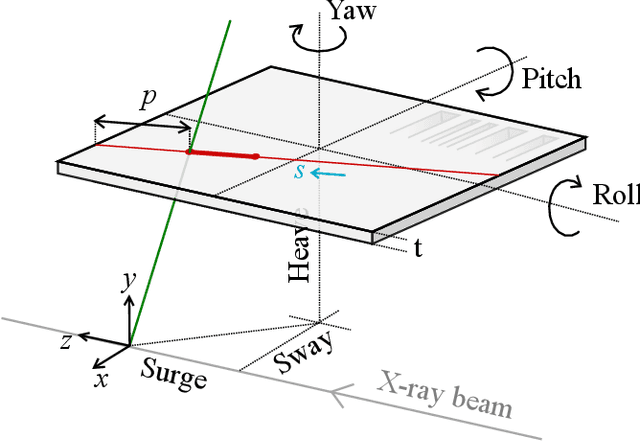
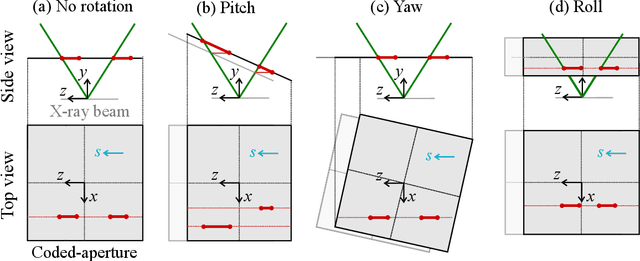

Abstract:To provide optimal depth resolution with a coded-aperture Laue diffraction microscope, an accurate position of the coded-aperture and its scanning geometry need to be known. However, finding the geometry by trial and error is a time-consuming and often challenging process because of the large number of parameters involved. In this paper, we propose an optimization approach to automate the focusing process after data is collected. We demonstrate the robustness and efficiency of the proposed approach with experimental data taken at a synchrotron facility.
Depth-resolved Laue microdiffraction with coded-apertures
Mar 03, 2022



Abstract:We introduce a rapid data acquisition and reconstruction method to image the crystalline structure of materials and associated strain and orientations at micrometer resolution using Laue diffraction. Our method relies on scanning a coded-aperture across the diffracted x-ray beams from a broadband illumination, and a reconstruction algorithm to resolve Laue microdiffraction patterns as a function of depth along the incident illumination path. This method provides a rapid access to full diffraction information at sub-micrometer volume elements in bulk materials. Here we present the theory as well as the experimental validation of this imaging approach.
CodEx: A Modular Framework for Joint Temporal De-blurring and Tomographic Reconstruction
Nov 11, 2021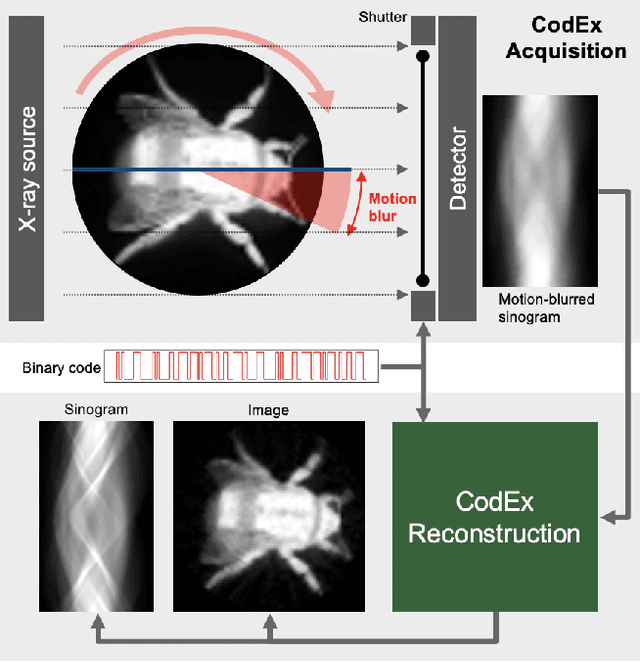
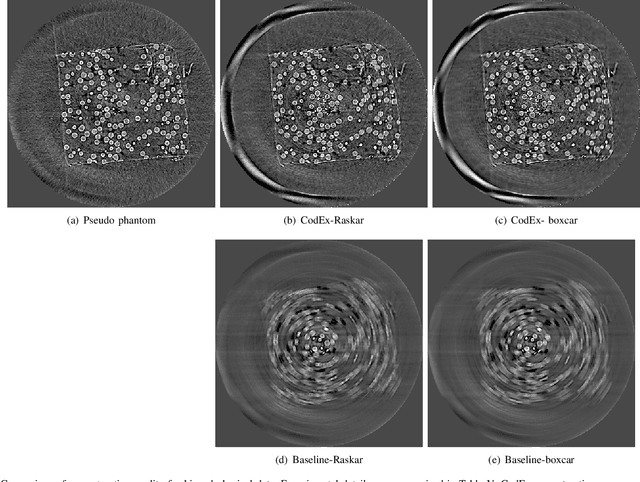
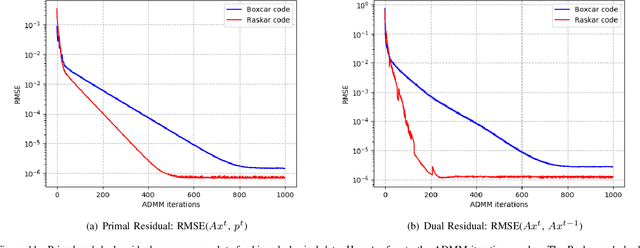
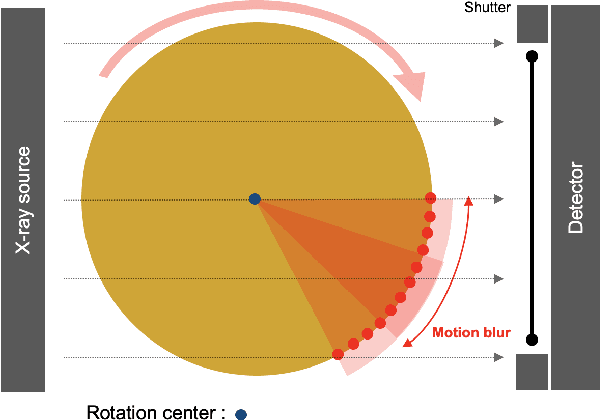
Abstract:In many computed tomography (CT) imaging applications, it is important to rapidly collect data from an object that is moving or changing with time. Tomographic acquisition is generally assumed to be step-and-shoot, where the object is rotated to each desired angle, and a view is taken. However, step-and-shoot acquisition is slow and can waste photons, so in practice fly-scanning is done where the object is continuously rotated while collecting data. However, this can result in motion-blurred views and consequently reconstructions with severe motion artifacts. In this paper, we introduce CodEx, a modular framework for joint de-blurring and tomographic reconstruction that can effectively invert the motion blur introduced in fly-scanning. The method is a synergistic combination of a novel acquisition method with a novel non-convex Bayesian reconstruction algorithm. CodEx works by encoding the acquisition with a known binary code that the reconstruction algorithm then inverts. Using a well chosen binary code to encode the measurements can improve the accuracy of the inversion process. The CodEx reconstruction method uses the alternating direction method of multipliers (ADMM) to split the inverse problem into iterative deblurring and reconstruction sub-problems, making reconstruction practical to implement. We present reconstruction results on both simulated and experimental data to demonstrate the effectiveness of our method.
Scalable and accurate multi-GPU based image reconstruction of large-scale ptychography data
Jun 14, 2021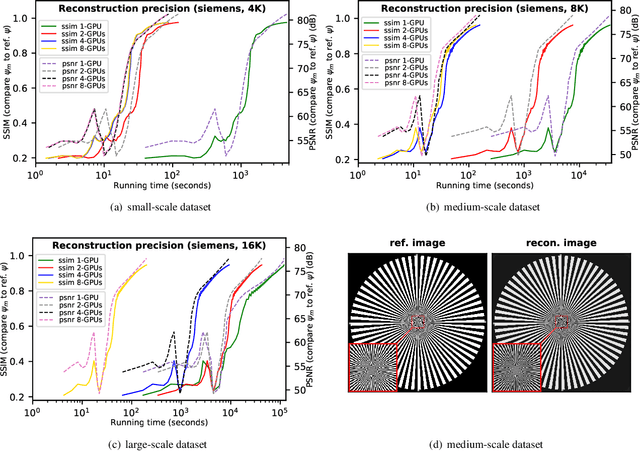
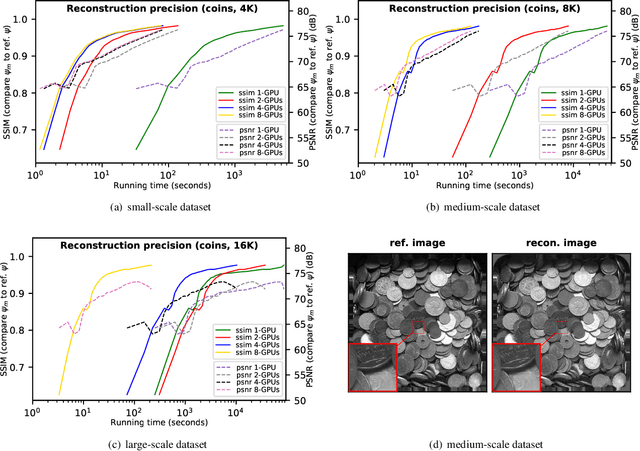
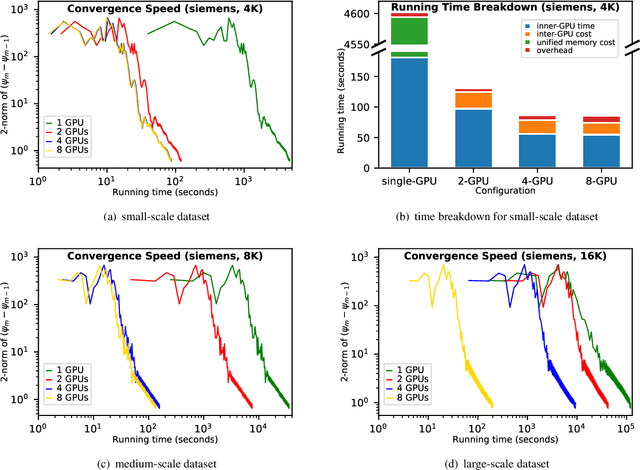
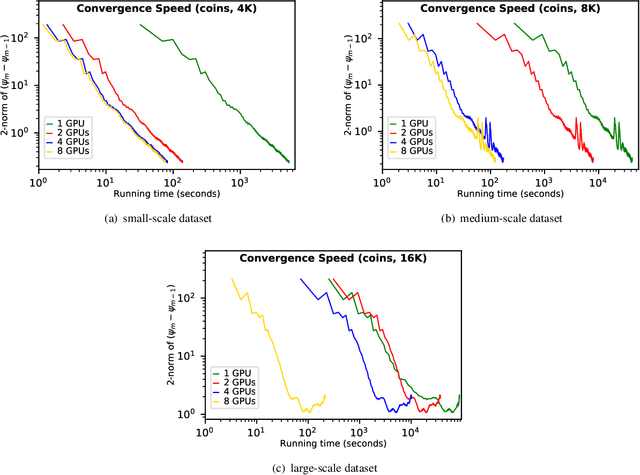
Abstract:While the advances in synchrotron light sources, together with the development of focusing optics and detectors, allow nanoscale ptychographic imaging of materials and biological specimens, the corresponding experiments can yield terabyte-scale large volumes of data that can impose a heavy burden on the computing platform. While Graphical Processing Units (GPUs) provide high performance for such large-scale ptychography datasets, a single GPU is typically insufficient for analysis and reconstruction. Several existing works have considered leveraging multiple GPUs to accelerate the ptychographic reconstruction. However, they utilize only Message Passing Interface (MPI) to handle the communications between GPUs. It poses inefficiency for the configuration that has multiple GPUs in a single node, especially while processing a single large projection, since it provides no optimizations to handle the heterogeneous GPU interconnections containing both low-speed links, e.g., PCIe, and high-speed links, e.g., NVLink. In this paper, we provide a multi-GPU implementation that can effectively solve large-scale ptychographic reconstruction problem with optimized performance on intra-node multi-GPU. We focus on the conventional maximum-likelihood reconstruction problem using conjugate-gradient (CG) for the solution and propose a novel hybrid parallelization model to address the performance bottlenecks in CG solver. Accordingly, we develop a tool called PtyGer (Ptychographic GPU(multiple)-based reconstruction), implementing our hybrid parallelization model design. The comprehensive evaluation verifies that PtyGer can fully preserve the original algorithm's accuracy while achieving outstanding intra-node GPU scalability.
TomoGAN: Low-Dose X-Ray Tomography with Generative Adversarial Networks
Mar 09, 2019



Abstract:Synchrotron-based x-ray tomography is a noninvasive imaging technique that allows for reconstructing the internal structure of materials at high spatial resolutions. Here we present TomoGAN, a novel denoising technique based on generative adversarial networks, for improving the quality of reconstructed images for low-dose imaging conditions, as at smaller length scales where higher radiation doses are required to resolve sample features. Our trained model, unlike other machine-learning-based solutions, is generic: it can be applied to many datasets collected at varying experimental conditions. We evaluate our approach in two photon-budget-limited experimental conditions: (1) sufficient number of low-dose projections (based on Nyquist sampling), and (2) insufficient or limited number of high-dose projections. In both cases, angular sampling is assumed to be isotropic, and the photon budget throughout the experiment is fixed based on the maximum allowable radiation dose. Evaluation with both simulated and experimental datasets shows that our approach can reduce noise in reconstructed images significantly, improving the structural similarity score for simulation and experimental data with ground truth from 0.18 to 0.9 and from 0.18 to 0.41, respectively. Furthermore, the quality of the reconstructed images with filtered back projection followed by our denoising approach exceeds that of reconstructions with simultaneous iterative reconstruction.
 Add to Chrome
Add to Chrome Add to Firefox
Add to Firefox Add to Edge
Add to Edge